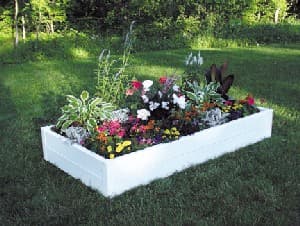Raised Garden Soil

About Preparing Soil for Raised Garden Beds
You’ve just placed a raised bed in your garden, and it looks great. You can’t wait to start growing great flowers or vegetables in it. Should you just load it with the surrounding soil? Or, should you make the soil in your new raised bed extra special, for those extra special plants? What garden soil mixture should you use? Why you know the answer to this question. Give your plants the ideal, rich raised garden soil that they deserve.
Raised bed gardeners are a special lot. We seek to create a rich garden soil, to produce stunning, outstanding gardens. We want you to do so, also, without spending money on garden soil or peat moss at the garden stores.
Preparing Raised Garden Bed Soil
The first step is to dig up the grass or weeds. This can be done before or after you set the bed frame in place. The raised garden soil depth should be a foot or more below the ground level. The soil at this depth, is usually far less friendly to your plants, than your garden topsoil. Garden topsoil often goes down just a few inches. Yet, the roots of many plants can go down to a foot in depth in just a single season.
Now your raised bed is ready to be filled with the richest soil you can create, far better than the surrounding topsoil.
As you fill the bed, put in a variety of materials in layers.
Start with a thick layer of compost. In the first layer, it is fine to use un-decomposed compost. By the time, your plant’s roots reach this area, the material will be ready for your plant to use. It is also okay to include a few fresh grass clippings in the bottom layer. You can also mix in some wood ash in this first layer. Wood ash is slightly alkaline and helps to offset the sometimes acidic compost.
Next, put in a layer of garden soil.
The third layer is manure. Use well-rotted(decomposed) manure. If this is not available to you, manure is available in bags at garden stores.
Follow the manure with another layer of garden soil.
Continue to layer in compost, garden soil, and manure. The final two layers should be compost, followed by garden soil on top.
Fill your raised bed a few weeks before planting, if possible. This allows for settling of the materials, before planting.
Plants in Your Raised Bed Deserve the Finest Quality Soil
A word about Peat Moss – Sure, you can certainly mix in peat moss. It is a wonderful and rich soil amendment. But, with ample amounts of compost, there is no need to spend a penny on peat moss. The benefits of peat moss are looser soil and good water retention. The compost you use does the same thing. More on Peat Moss
To mix or not to mix– Gardeners often ask us how to mix raised garden soil. If you use the layered approach above, mixing the materials is not necessary. If you feel better about mixing the materials first, you can certainly do so. There is no right or wrong way to mix the materials you use.
Recharging Raised Garden Soil
We recommend emptying and refilling raised garden soil each year. Fall is a great time to set up your raised garden for next season. Garden waste and dead plants can be put directly into the raised bed. Also, you can also put raw manure into it at this time. The materials will decompose underground during the winter months. Then, your raised bed will be ready for planting in the spring.
Related Articles
Please support our site. Shop for:
- rmmatthews100@hotmail.com
- 585-721-6528
- Rochester, NY
©1999-2024 GardenersNet.Com, All Rights Reserved

